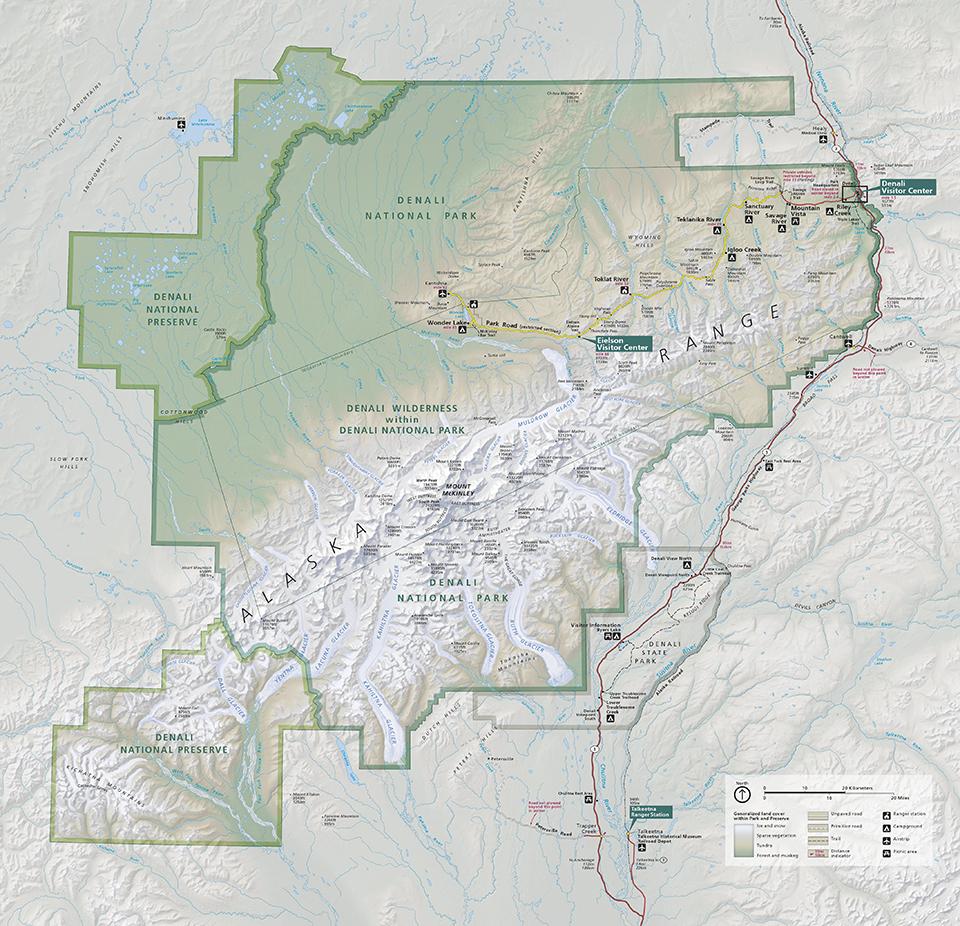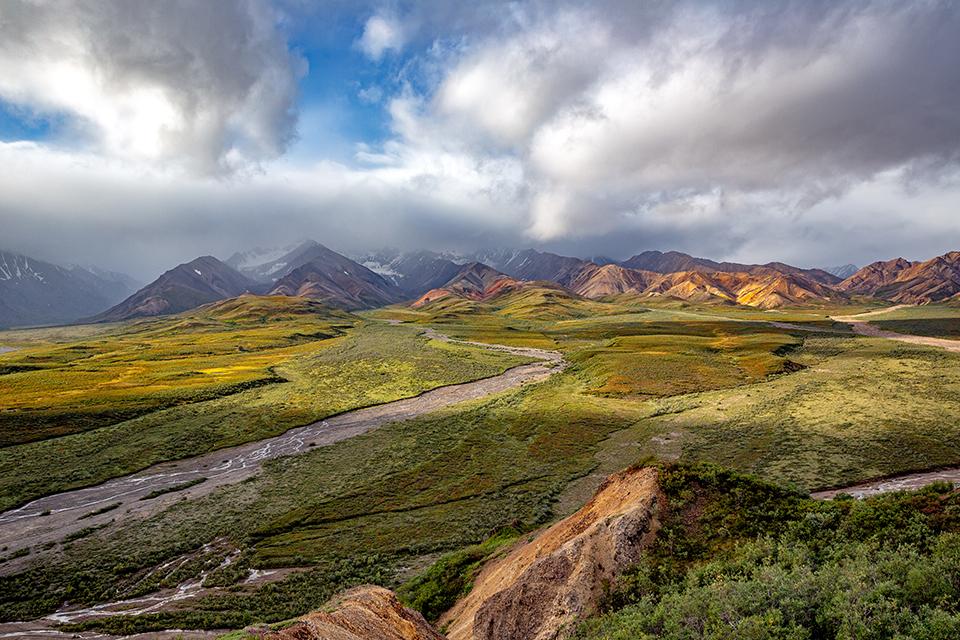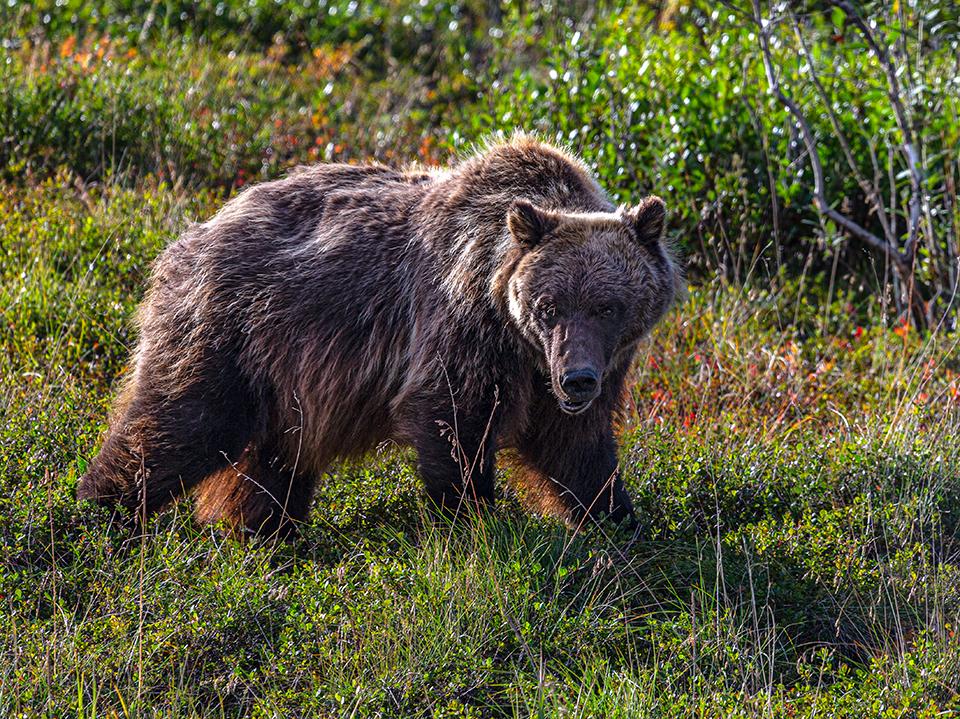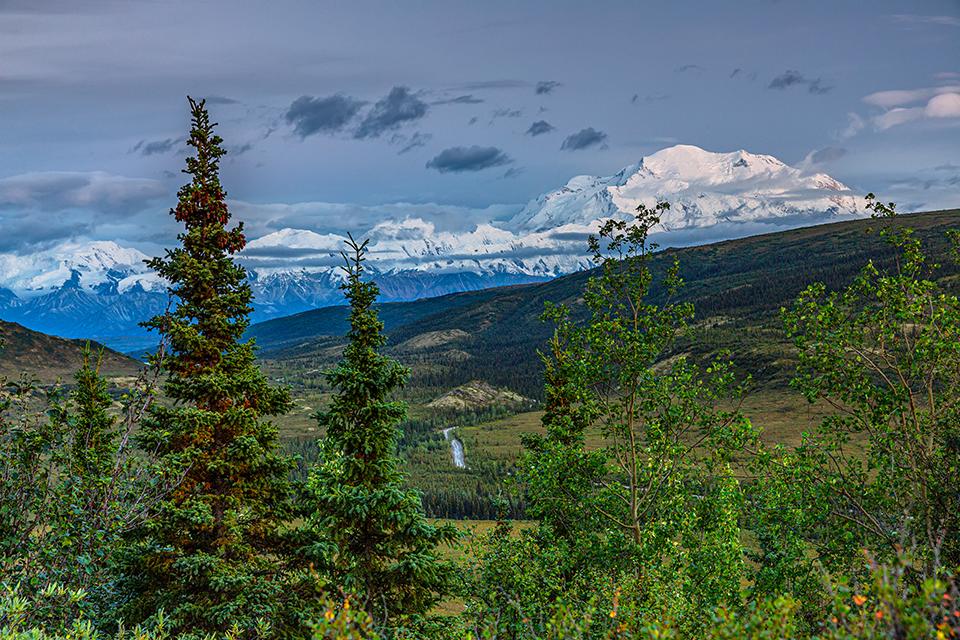
Denali's majesty, Denali National Park and Preserve / Rebecca Latson
Only 30 percent of visitors to Denali National Park and Preserve are ever able to fully view its namesake mountain (fka Mount McKinley). Fortune smiled upon me during a trip to this national park several years ago, and I saw the intense majesty of Denali and its Alaska Range siblings.
Even if you are unable to get a full glimpse of North America's tallest mountain during your visit, don’t let that discourage you from taking advantage of all the things you can do and see in the park. If you’ve got a yearning to travel to Denali, then you’ll need to do a little planning, and this Traveler’s Checklist can help you make the most of your time exploring this six-million-acre park of wild land and wildlife, where you might spot a caribou, Dall sheep, moose, bear, or wolf.
Unless you already live in Alaska, you’re probably going to be flying to this state, then driving four hours from Anchorage, or two hours from Fairbanks to arrive at the park entrance.

Map of Denali National Park and Preserve / National Park Service
- Weather is variable in the park, even during summer (late May through early September). Pack raingear, a sweater, and jacket along with your lighter fare. When I visited in August, I wore fleece every day. Granted, my workouts were not as strenuous as someone hiking in the backcountry, but the weather was breezy and on the cool side even then. Definitely throw in a pair of sturdy hiking boots for your on- and off-trail excursions.
- There is one road entrance into the park, and you’ll only be able to drive the first 15 miles of the road, and that’s during the summer. So, to really see the sights of this vast national park, reserve a spot on one of the buses that travel the 92-mile park road. You can choose from a narrated or non-narrated (transit) bus tour. Of course, if you happen to enter and win one of the spots for the September four-day Denali Road Lottery, then you can drive as much of the road in a single day as weather allows (better check to see if your car rental agency allows travel on gravel roads). If you are an active-duty member of the military, you and your family can apply for a road travel permit for Military Appreciation Day, an extra fifth day of the lottery. FYI, the military is in charge of distributing road travel permits for that particular day.
- There aren’t any National Park Service-operated lodges within the park, but there are lodges on privately-owned land (inholdings) where you can stay (Camp Denali & North Face Lodge, Kantishna Roadhouse, Denali Backcountry Lodge, and Skyline Lodge). With the exception of Skyline Lodge, where you can either take an NPS-operated bus to the Kantishna area or fly there with Kantishna Air Taxi, these other lodging choices have their own buses to ferry you to and from their locations, and each offers various park excursions. I wrote a story for the Traveler about my Camp Denali stay. There’s also lodging outside of the park, in Healy (11 miles from the park), Cantwell (30 miles from the park) and along the highway between those two communities.
- If camping is more your style, there are six campgrounds within the park for tent and RV camping, as well as campgrounds and RV sites outside of the park.
- It goes without saying, to get a better feel for the park, you should go hiking. Denali National Park is a place where you can hike on or off the trail. This park doesn’t have too many marked trails, and most of them are pretty short (less than 2 miles). It’s the off-trail hiking that’s one of the adventures of visiting Denali. Imagine walking on springy tundra – sort of feels like walking on a bed mattress, which in turn means you need to watch your step. If you plan on backcountry hiking, you’ll need a permit, a plan, bear spray, and you should follow the Leave No Trace Principles. Actually, you should follow those principles regardless of what you do within the park.
- Go on a flightseeing tour and walk on a glacier! From personal experience, there’s nothing like the adventure of seeing the park and its glaciers from the air, then actually walking on one of those “rivers of ice.”
- Spend one or more days cycling. You can bicycle all 92 miles of the park road. If you don’t bring a bike with you, a Google search will show you businesses from which you can rent a bike. Don’t forget to pack or rent a helmet, too. Bicyclists must obey the same rules of the road that other vehicles follow.
- Join a park ranger program or go on a field seminar. Watch a sled dog demonstration, walk with a ranger and learn about the park’s environment, or take a multi-day, hands-on field course “led by distinguished scientists, authors and naturalists.”
- Speaking of sled dogs, how about visiting the kennels, open year-round and located about three miles inside the park. FYI, pets are prohibited from the kennels at all times.

Morning light over Polychrome Pass, Denali National Park and Preserve / Rebecca Latson
- Bring your camera for some photography. What’s a trip to this wild national park without bringing back stunning landscape and wildlife images? There are view areas to which you can drive your car along that 15-mile stretch of paved road and, of course, any bus tour you choose will offer opportunities to stop and capture photos. I wrote an article for the Traveler about photography in Denali.

A grizzly in the grass, Denali National Park and Preserve / Rebecca Latson
- Make sure you’ve packed binoculars or a telephoto lens for wildlife viewing. You might see a wolf on the road in front of the bus, a bear feeding on the berry bushes right next to the road, or a moose or caribou way out on the tundra. Just remember to keep your distance from all wildlife, and NO FEEDING the wildlife. Keep the wildlife wild.

A gaggle of geese in the water, Denali National Park and Preserve / Rebecca Latson
- Go birdwatching. Summer is a great time to view the birds, and you might see grouse or ptarmigan in the bushes along the roadside, ducks, swans, grebes, and loons in the ponds and boggy areas, and cranes, osprey, falcons and eagles, to name but a few of the over 160 avian species that visit or live within the park.
- If you are looking for something more adventurous, test your mountaineering skills climbing North America’s highest peak, or scaling vertical rock and ice walls in the park. You’ll need to plan and prepare for your climbing adventure in order to have a “safe and successful journey in the Alaska Range.”
- Pack your fishing rod and tackle box. While glacial conditions make lakes and streams silty and thus poor habitat for fish, if you are willing to look for clearer waters, then you might be able to catch a few fish, and you don’t need a fishing license except for those areas within new park additions and the national preserve portion of the park.
- A winter visit to Denali National Park and Preserve reveals a different landscape and opens up a variety of activities, such as mushing (bring your own dogs or book a trip with a guide), snowshoeing, skiing, skijoring (what’s that?), and snowmobiling. If you are lucky, you might see the Aurora Borealis in this park during your stargazing on clear nights. You might want to check and see if there are any winter ranger programs, too.
- Before you go on your trip, remember to check the park’s website to find out if and where pets are allowed and whether or not there are any closures or restrictions due to the season, construction, weather, or Covid-19.
- As you make your trip plans, remember, the coronavirus pandemic is not over, yet. Per the National Park Service, whose parent organization is the Department of the Interior: “To protect the health of those who live, work, and visit America’s national parks, face masks are required in all NPS buildings and facilities. Masks are also required on NPS-managed lands when physical distancing cannot be maintained, including narrow or busy trails, overlooks, and historic homes.” So, travel safely, take some masks, practice social distancing and wash your hands often.

The blush of dawn over Denali and the Alaska Range, Denali National Park and Preserve / Rebecca Latson



Add comment